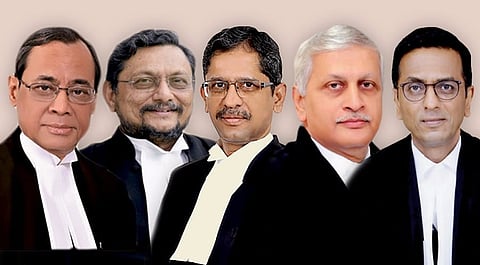
- Latest Legal News
- News
- Dealstreet
- Viewpoint
- Columns
- Interviews
- Law School
- Legal Jobs
- हिंदी
- ಕನ್ನಡ

The recent appointments of Justices Indira Banerjee, Vineet Saran and KM Joseph – and earlier, Justice Indu Malhotra – to the Supreme Court have given us a better picture of what the Supreme Court Collegium will look like in the years to come.
The Collegium, which is the body primarily responsible for appointments to the higher judiciary in India, will be headed by five different Chief Justices over the course of the next six years.
The first of these will be Justice Ranjan Gogoi, who will take over at the helm on October 3 this year, after current CJI Dipak Misra attains superannuation.
Here is a look at the next five Chief Justices and their Collegiums.
Tenure as Chief Justice: October 3, 2018 – November 17, 2019
Parent High Court: Gauhati High Court
After serving as a judge of the Gauhati High Court for over a decade, Justice Gogoi was appointed Chief Justice of the Punjab & Haryana High Court in 2011, before being elevated as an apex court judge in April 2012.
There have been rumours that the Centre might oppose his elevation as CJI, in light of being part of the unprecedented Judges Press Conference that took place this year. In any case, things will be cleared in a couple of months’ time. If and when he assumes office in October 2018, he will become the first CJI from a North-Eastern state.
As noted above, Justice Gogoi will have seven different judges as part of the Collegium during his tenure.
Tenure as Chief Justice: November 18, 2019 – April 23, 2021
Parent High Court: Bombay High Court
The son of former Maharashtra Advocate General Arvind Bobde and brother of veteran lawyer Vinod Bobde, Justice SA Bobde found his way to the legal profession in 1978.
He was elevated as an additional judge of the Bombay High Court in 2000, before being appointed as Chief Justice of the Madhya Pradesh High Court in 2012. He became a judge of the Supreme Court in April 2013.
Justice R Banumathi will become the second ever woman to be part of the Supreme Court Collegium – after Justice Ruma Pal – when Justice Bobde takes charge as Chief Justice on November 18, 2019.
Tenure as Chief Justice: April 24, 2021 – August 26, 2022
Parent High Court: Andhra Pradesh High Court
Justice Ramana was appointed as a judge in the High Court of Judicature at Hyderabad in the year 2000. From there, he was appointed as Chief Justice of the Delhi High Court in 2013, before being elevated to the Supreme Court in February 2014.
Justice Ramana will be the first judge of the High Court of Judicature at Hyderabad to be appointed Chief Justice of India.
Tenure as Chief Justice: August 27, 2022 – November 8, 2022
Parent High Court: N/A (Elevation from Bar)
Justice Lalit enrolled at the Bar in 1983 and went on to have a lucrative career as a lawyer in Bombay and Delhi. He was designated as Senior Advocate by the Supreme Court in 2004. He answered the call to the Bench in August 2014, when he was directly elevated to the apex court.
He will have one of the shortest tenures (73 days) as Chief Justice of India before retiring in November 2022.
The Collegium headed by Justice Lalit will have two judges who were elevated from the Karnataka High Court.
Tenure as Chief Justice: November 9, 2022 – November 10, 2024
Parent High Court: Bombay High Court
While Justice Lalit’s tenure as CJI will be one of shortest, his successor’s tenure will be one of the longest in the last ten years. Justice Chandrachud will create history on November 9, 2022, when he assumes office as Chief Justice of India. On that day, he and his father Justice YV Chandrachud will have been the only father-son CJI duo in Supreme Court history.
A Harvard University graduate, he was appointed as a judge in the Bombay High Court in 2000, before taking charge as Chief Justice of the Allahabad High Court in 2013. In May 2016, he was elevated to the Apex Court.
Collegium: Justice Sanjay Kishan Kaul (till 26/12/23); Justice Mohan M Shantanagoudar (till 4/5/23); Justice Abdul Nazeer (till 4/1/23), Justice KM Joseph (till 17/6/23).
Justice KM Joseph, who was in the news recently, will get the chance to serve on the Collegium despite being appointed as a judge junior to Justices Indira Banerjee and Vineet Saran, who will both attain superannuation in 2022.
By the end of his tenure in November 2024, Justice Chandrachud’s Collegium will have four judges who are yet to be appointed to the Supreme Court.